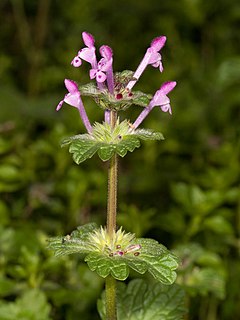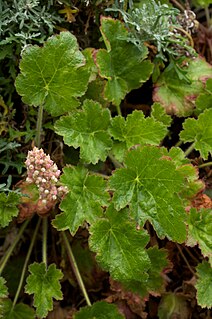
Lamium amplexicaule, commonly known as common henbit, or greater henbit, is a species of Lamium native to Europe, Asia and northern Africa.

Lepechinia fragrans is a flowering herbaceous shrub known by the common names island pitchersage and fragrant pitchersage. It is a member of the Lamiaceae, or mint family, but like other Lepechinia, the flowers are borne in racemes instead of in mintlike whorls.

Epilobium palustre is a species of willowherb known by the common name marsh willowherb. This plant has a circumboreal distribution, and can be found farther south in mountainous areas.

Heuchera pilosissima is a species of flowering plant in the saxifrage family known by the common name seaside alumroot and Parish's alumroot. It is endemic to the northern two thirds of the California coastline, where it grows on coastal bluffs and in nearby forests. This is a rhizomatous perennial herb producing lobed oval-shaped leaves 4 to 9 centimeters wide, each on a long petiole. The erect inflorescence reaches over half a meter in maximum height and is covered in glandular hairs. It bears dense clusters of rounded, hairy flowers. Each flower has pink or yellowish lobes tipped with small white or pink petals. The stamens and stigma protrude from the narrow mouth of the flower.
Senecio mattirolii is a perennial herb of the family Asteraceae endemic to altitudes between 3600–4500 meters on the slopes of the mountains of the Ruwenzori Mountains in Uganda and the Democratic Republic of the Congo and an atypical species of the genus Senecio because it has purple flowers.

Acanthomintha lanceolata is a species of flowering plant in the mint family known by the common name Santa Clara thornmint. It is endemic to California, where it is known from several counties surrounding and south of the San Francisco Bay Area. It is an uncommon resident of rocky habitat in coastal and inland mountain ranges.

Isopogon dubius, commonly known as pincushion coneflower, is a species of plant in the family Proteaceae and is endemic to the south-west of Western Australia. It is a shrub with sharply-pointed, deeply lobed or pinnate leaves and more or less spherical heads of pink to reddish pink flowers.
Calycadenia oppositifolia is a species of flowering plant in the family Asteraceae known by the common name Butte County western rosinweed. It is native primarily to Butte County, California, although a few populations have been found in other parts of the state. It grows in the foothills of the high mountain ranges.

Chorizanthe cuspidata is a species of flowering plant in the buckwheat family known by the common name San Francisco spineflower. It is endemic to California, where it is known only from the San Francisco Bay Area and to the immediate north and south. It grows in sandy coastal habitat.
Collinsia greenei is a species of flowering plant in the plantain family known by the common name Greene's blue-eyed Mary.
Cordylanthus pilosus is a species of flowering plant in the family Orobanchaceae known by the common name hairy bird's beak. It is endemic to the mountain ranges and foothills of northern California, where it grows in woodland and chaparral habitat, often on serpentine soils. There are three subspecies, each mainly limited to a different section of mountains. In general this annual herb is erect and branching, reaching a maximum height anywhere between 20 centimeters and 1.2 meters. It is purple-tinted gray-green in color and usually quite hairy in texture, the hairs sometimes associated with sticky glands. The branches have sparse tufts of small linear leaves. The flowers of the inflorescence have bracts which may be linear in shape or lobed, each lobe knobby or notched. The flower is up to 2 centimeters long and has a whitish pouch marked with yellow and purple enclosed in hairy sepals.

Lessingia leptoclada is a species of flowering plant in the family Asteraceae known by the common name Sierra lessingia. It is endemic to the Sierra Nevada of California, where it is known from several types of local habitat. This is a slender annual herb growing erect and varying in size from just a few centimeters to nearly a meter tall, with long, spreading branches. It is very glandular and often hairy or woolly in texture. The upper leaves are up to 5 centimeters long, narrow and sometimes toothed or lobed; the lower leaves are longer and wither early. The flower heads appear singly or in small clusters. Each head is lined with woolly phyllaries. The head is discoid, containing no ray florets but many funnel-shaped pinkish, lavender, or light bluish-purple disc florets with large lobes. The fruit is an achene with a whitish pappus of bristles.

Erythranthe bicolor, the yellow and white monkeyflower, is a species of flowering plant in the lopseed family (Phrymaceae). It is endemic to California, United States. It was formerly known as Mimulus bicolor.
Erythranthe breweri is a species of monkeyflower known by the common name Brewer's monkeyflower. It is native to western North America from British Columbia to California to Colorado, where it grows in moist spots in several habitat types. This is a hairy annual herb producing a thin, erect stem up to 21 centimeters tall. The herbage is reddish green in color. The paired opposite leaves are linear in shape and up to 3.5 centimeters long. The plant bears small tubular flowers, each with its base encapsulated in a lightly hairy calyx of sepals with tiny equal lobes at its mouth. The five-lobed flower corolla is just a few millimeters long and light purplish pink in color, often with darker spots in the throat. It was formerly known as Mimulus breweri.
Nemacladus gracilis is an uncommon species of flowering plant in the bellflower family known by the common names slender threadplant or slender nemacladus. It is endemic to California, where it is known from the Transverse Ranges and adjacent mountains, desert, and valley territory. It can be found in rocky and sandy areas in woodland and grassland habitat. It is a small annual herb producing an upright reddish brown stem no more than about 10 centimeters long. Small lobed oval leaves under a centimeter long occur at the base of the plant. The inflorescence is a series of branches bearing occasional flowers on thin, curving pedicels. There is a single tiny bract at the base of each pedicel. The flower is only about 2 millimeters long. It has five lavender-veined white lobes fused along the lower half.
Pedicularis howellii is an uncommon species of flowering plant in the family Orobanchaceae known by the common name Howell's lousewort. It is endemic to the Siskiyou Mountains of the Klamath Range in southern Oregon and northern California, where it grows on the edges of coniferous forests. This is a perennial herb producing one or more stems up to 45 centimetres (18 in) tall from a long caudex. The leaves are up to 20 centimetres (8 in) long, lance-shaped, and divided into many toothed oval lobes; those higher on the stem may be unlobed. The basal leaves fall away early. The inflorescence is a small raceme of flowers occupying the top of the stem. Each white to light purple flower is up to one centimetre long and is sickle-shaped, with a curved beak-like upper lip and a three-lobed lower lip which may be tucked into the hairy mass of sepals. The plant is pollinated by bumblebees including Bombus mixtus. Between the flowers are hairy to woolly triangular bracts. The fruit is a capsule just under a centimeter long containing seeds with netted surfaces.

Phacelia davidsonii is a species of phacelia known by the English name Davidson's phacelia named by Asa Gray for the discoverer of this annual plant, Anstruther Davidson, a Scottish naturalist who emigrated from Scotland to Los Angeles, California, in the late nineteenth century. This native forb occurs in southern California and southern Nevada, where it grows in mountains and foothills in chaparral and woodland habitats. In California, this herb is found in the Southern Sierra Nevada, Transverse Ranges, and Peninsular Ranges.
Salix balfouriana is a shrub or small tree from the genus of willow (Salix) with reddish black and tomentose hairy young twigs and up to 8 leaf blades, rarely 18 centimeters long. The natural range of the species is in China.
Salix chingiana is a small tree in the willow genus Salix with dull purple-colored, bare branches. The stipules are permanent, the leaf blades are 7 to 10 centimeters long. The natural range of the species is in China.
Larsenianthus assamensis is a species of the genus Larsenianthus in the ginger family (Zingiberaceae). It was first described in 2010 and is native to northeastern India.










